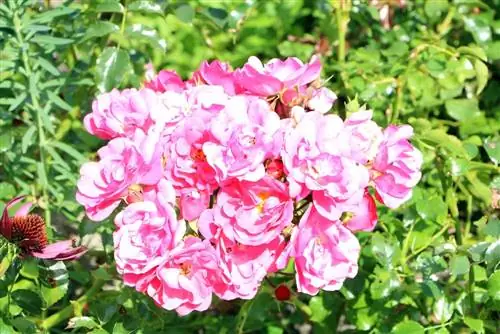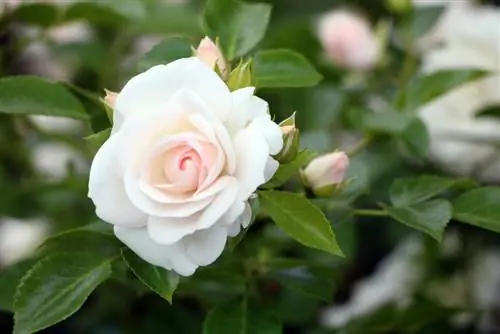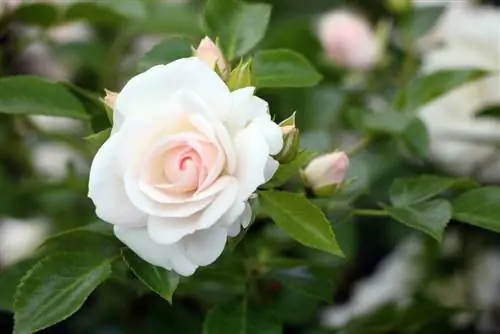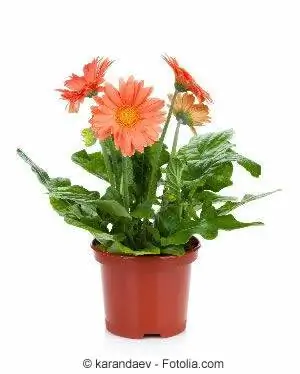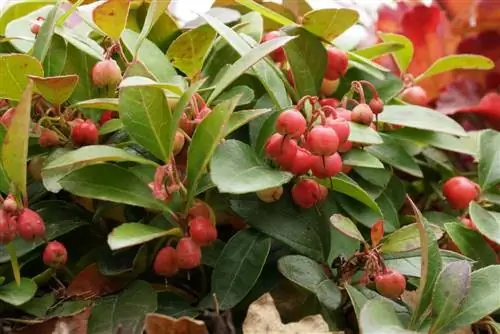- Author admin [email protected].
- Public 2023-12-17 03:39.
- Last modified 2025-01-24 12:45.
If you don't have your own garden, you can also grow roses in a pot on the balcony or terrace. The beautiful flowers thrive magnificently in summer, but these deep-rooted plants have certain requirements when it comes to care, pot size and location selection. Over time, repotting is necessary as the roots continue to grow and need more space in the planter.
Location
When roses grow in pots, they place special demands on the location. These requirements change constantly depending on the season, sunlight and temperatures. Since the bucket is mobile, it is advisable to move it depending on the prevailing conditions. If the places are too hot and have a continuous canopy, the roses will be extremely stressed. This quickly leads to problems with pests, especially mildew and spider mites. Rose varieties with small foliage tolerate strong sunlight and persistent heat much better than large-leaved varieties.
- Location should be sunny for a few hours a day
- Light partial shade is ideal
- Full sun is not tolerated so well
- West or east side is optimal
- Too much heat builds up on south walls
- Make sure there is sufficient ventilation
- Do not cover permanently
- Place in free space until flowering
- Cover for a few weeks during flowering and hot temperatures
- Roofing must have adequate ventilation
- After flowering, place again in a free location
Pots & plant substrate
When planting, it is important to ensure that the pot is of sufficient size. Since roses have extremely deep roots, they require a lot of space in the planter. The roots should under no circumstances touch the walls of the bucket or pot. The material of the rose pot doesn't play as important a role as its dimensions. However, roses place high demands on the nutrient content of the planting substrate and cannot tolerate prolonged moisture in the pot. That's why special rose soil is perfect for the plants, as its structure is significantly coarser than that of normal potting soil. Thanks to this structure, the plant is protected from permanent waterlogging. This soil also contains draining components and an optimal acidity, which promotes the growth of roots.
- Use pots with a height of at least 50 cm
- Diameter of at least 40 cm
- Noble, climbing and shrub roses need a pot height of at least 70 cm
- Pots made of plastic, fiberglass and terracotta are possible
- Nutritious rose soil is ideal
- Alternatively use soil for potted plants
- Enrich the substrate with calcareous stone powder
- Renew the plant substrate every year, if possible in spring
Tip:
You can also make a nutrient-rich plant substrate yourself by mixing around 30 percent compost with high-quality potting soil, which consists of clay and sand.
Planting & Repotting
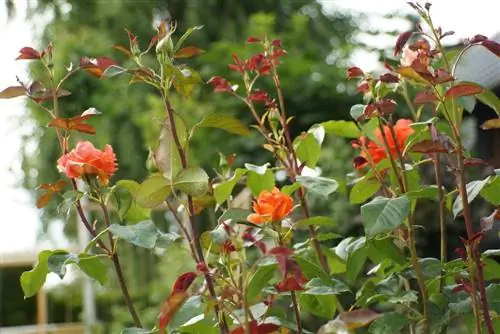
Before planting in the pot, roses should be treated in the same way as if the flowers were moving into a garden bed. When planting in the pot, make sure there is a sufficient watering edge so that the water cannot run over the edge of the pot when watering. You shouldn't plant too many roses in one pot, although several of them would fit in a larger planter. After a short time, the plants compete for the available water, nutrients and root space. Roses must be repotted after a few years because they have strong root growth. If the plants no longer have enough space in the pot, this circumstance has a negative effect on their above-ground growth. When repotting, it is very important to handle it carefully so as not to unnecessarily damage the sensitive roots.
- Put container roses in a water bath before planting
- Cutting back bare-rooted plants
- When planting, place in the middle, away from the walls
- Cover the root ball with about 2 cm of plant substrate
- The grafting point should be at least 5 cm above the ground
- Leave the pouring edge of about 5 cm
- A continuous water drain is important
- Lay a layer of pottery shards or pebbles over the drain hole
- Above this, a drainage layer made of expanded clay or lava grit, approx. 3-5 cm
- No more than 2 roses per planter
- Repot container roses in a larger planter every 3-4 years
- How to plant
Watering & Fertilizing
If roses in the pot are not supplied with enough nutrients, then in extreme cases they may even fail to bloom. Therefore, it is important to ensure adequate nutrient intake. If the plants overwinter outside, fertilizer should no longer be applied from mid-June onwards. Otherwise, the plants would continue to grow new shoots that would no longer have enough time to fully mature before the winter cold and would therefore be very susceptible to frost damage. If overwintering in a frost-free winter quarter is possible, then the plants should be fertilized throughout the entire growing season. Container roses are also very demanding when it comes to watering; the flowers neither like it too dry nor too wet. Therefore, the irrigation water must always be able to drain well, as the delicate flowers cannot tolerate permanently wet feet.
- Water regularly, but not too much at once
- Top layer of soil should be dry first
- Root ball must never dry out completely
- Prevent waterlogging at all costs
- Ideally fertilize for the first time in spring
- Container roses prefer long-term and liquid fertilizers
- Help with liquid fertilizer during the flowering period
- Additional potassium fertilizer between mid-August to the end of September
Cutting
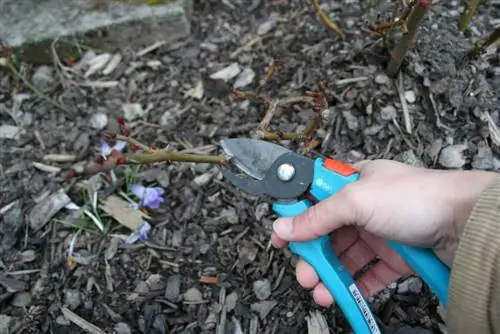
When pruning container roses, the same rules should be followed as with ordinary roses. This should only be started when the strongest frosts have largely passed. You can definitely take a radical approach to cutting, except for shrub or climbing roses that bloom once. These varieties should only be shortened slightly. When pruning, growth should be promoted in width; the roses should not sprout inwards. It is important to have a good cutting tool so as not to squeeze the shoots unnecessarily
- Pruning in spring
- Cut back shoots to three eyes
- Last eye should always face outwards
- Place the interface approximately 5 mm above the eye
- Cut slightly at an angle so that water drains away faster
- Make sure you have very sharp secateurs
- Always cut back immediately if there is a fungal infection
Wintering
In winter, container roses still need care and must be protected from severe frost temperatures. Ideally, the plants can move indoors, but not into the basement or a dark storage room, as light is still needed. It is also possible to overwinter at your usual location, but then certain protective measures must be taken. Since there are often strong storms in winter, the above-ground shoots must be protected from damage by winds.
- Moving to frost-free winter quarters is ideal
- Cool guest rooms, light hallways and bright attics are well suited
- Continue watering in winter, but no longer fertilize
- When overwintering outdoors, be sure to protect roots
- Wrap thick bubble wrap around the bucket, about 10 cm
- To insulate the bucket, place it on Styrofoam or coconut mat
- Cover exposed shoots with brushwood or burlap

